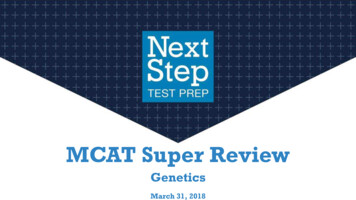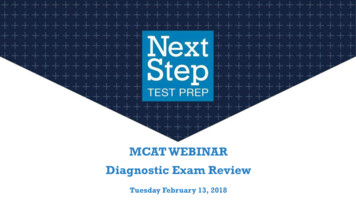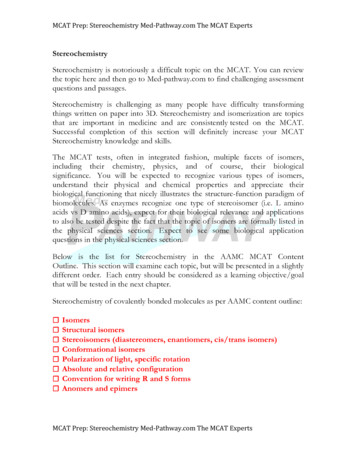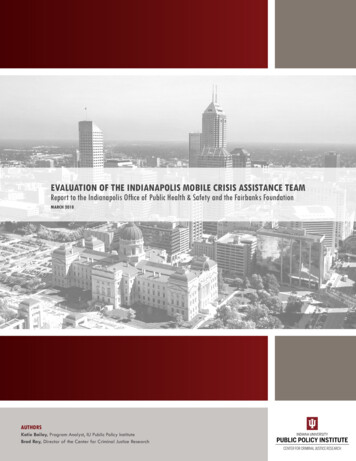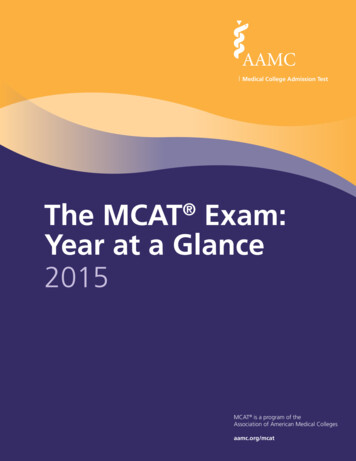
Transcription
Medical College Admission TestThe MCAT Exam:Year at a Glance2015 MCAT is a program of theAssociation of American Medical Collegesaamc.org/mcat
The MCAT Exam: Year at a Glance2015Students who took the Medical College Admission Test (MCAT ) in April 2015 took a different examthan the students who took it before them. This short report describes the new MCAT exam, shows howstudents prepared for it, and reports the characteristics of those who tested in 2015.1 It explains howscores from the new exam worked and how students from different sociodemographic groups scored.Also reported are the scores of those who submitted new MCAT scores in their 2016 applications tomedical school.Even though the 2015 MCAT exam is brand new, data are already available to show how new scorespredict performance in medical school. This guide reports correlations between medical school gradesand scores on a prototype of the Psychological, Social, and Biological Foundations of Behavior sectionof the new exam. It concludes with a description of ongoing research on the impact, use, and validity ofthe new test.This report is organized around eight questions:1.2.3.4.5.6.7.8.How is the new MCAT exam different from the old?What are the characteristics of students who took the new exam?How did examinees prepare for the new test?How well did the new score scales work?How well did examinees score on the new test?Which 2015 examinees applied for 2016 admission?What information is available about the predictive validity of scores from the new exam?What else will we learn about the impact, use, and validity of the new exam?1. This report describes the sociodemographic characteristics, academic preparation, and MCAT scores of examinees whosubmitted their test results for scoring. At every test administration, a small percentage of examinees decide to void theirresults; this report excludes data for these examinees.Association ofAmerican Medical Colleges
1. How is the new MCAT exam different from the old?The new MCAT exam shifts the focus from testing what students know to testing how well they usewhat they know. The blueprints for the new exam are evidence based and target concepts that medicalschool faculty, residents, and medical students recently rated as important to medical students’ success.The test is organized around the academic competencies described by two seminal reports in medicaleducation: Scientific Foundations for Future Physicians (2009) and Behavioral and Social SciencesFoundations for Future Physicians (2011).The new exam asks students to demonstrate their scientific reasoning skills by solving problems in thenatural, behavioral, and social sciences. It also asks test takers to reason about research and data. Thenew exam reflects the heavy information-processing requirements of medical school by havingexaminees demonstrate that they understand and can critically analyze text.The new and old exams are different. Like the old exam, the new exam tests concepts taught in the yearlong, baccalaureate courses of biology, general chemistry, organic chemistry, and physics, as well asverbal reasoning skills. The new exam, however, requires more: it asks applicants to solve problemsusing concepts taught in first-semester biochemistry, psychology, and sociology courses.ContentNew MCATExamOld MCATExamBiologyChemistry Physics VerbalReasoning Biochemistry PsychologySociology The new exam Asks students to apply what they’velearned by solving scientific problemsand reasoning about research and data Requires broader preparation Gives attention to the behavioral andsociocultural aspects of health Incorporates the latest science oninformation processingThe new exam consists of four sections. 2016 AAMC. May not be reproduced without permission.1
2. What are the characteristics of students who took the new exam?Almost 60,000 students took the new exam in 2015, and their characteristics mirrored those of previoustest takers. There was concern that some groups of examinees would be more reticent than others to takethe new exam. But students took the new exam in the same proportions as they took the old exam.Figure 1. Percentage of Examinees Taking the New MCAT Exam by Gender, Race/Ethnicity, FeeAssistance Status, Testing Condition, and Repeater Status (N ianAmerican Indian/Alaska NativeNative Hawaiian/Pacific IslanderOther48%11%11%Race/Ethnicity1,2Fee AssistanceTesting Condition3Repeater Status426%1% 1%4%Did Not peaterRepeater93%7%0%10% 20% 30% 40% 50% 60% 70% 80% 90% 100%Notes1. Percentages describe examinees who provided information about their gender and race/ethnicity.2. Percentages do not add up to 100% because some examinees reported multiple races or ethnicities.3. Score reports do not indicate whether scores were obtained under standard or nonstandard conditions.4. Repeaters are examinees who took the new MCAT exam multiple times in 2015. 2016 AAMC. May not be reproduced without permission.2
3. How did examinees prepare for the new test?As already mentioned, the new exam requires broader preparation than the old, testing concepts fromfirst-semester biochemistry, psychology, and sociology and asking students to demonstrate that they canreason about research and data.Data about courses the 2015 examinees took show how they prepared in these new areas. As in the past,almost all students took biology, chemistry, and physics. Most 2015 examinees took biochemistry,psychology, and statistics before testing; many took sociology and research methods. The numbers ofstudents taking courses in biochemistry, psychology, sociology, and statistics were higher than in thepast.The percentages of students who took commercial or university- or medical school-based preparationcourses before the new exam were similar to the past, with about half of the examinees takingpreparation courses for the new test.Figure 2. Percentage of Examinees Taking the New MCAT Exam Who Completed CollegeCoursework in the Natural, Behavioral, and Social Sciences or MCAT Preparation Courses(N earch l Chemistry83%Organic Chemistry95%Physics91%From a university/medical schoolMCATPreparationCourses7%Commercial43%0%10% 20% 30% 40% 50% 60% 70% 80% 90% 100%Note1. Percentages describe the preparation of examinees who provided information about their coursework and completion of MCATpreparation courses. Examinees reported the courses for which they had AP, IB, CLEP, community college, or four-year college credit. 2016 AAMC. May not be reproduced without permission.3
4. How well did the new score scales work?Because the new and old MCAT exams test different knowledge and skills, the scales for reporting thescores on the new exam have changed. This way, the scores on the new exam will acquire new meaningand won’t be confused with scores on the old exam. The new scales have round, memorable numbers atthe center so they draw attention to the middle of the scales and encourage admissions committees toconsider applicants who might otherwise be overlooked. Research on past exams shows that the vastmajority of students who enter medical school with scores in the center of the scale succeed. Thesestudents graduate in four or five years and pass their licensing exams on the first try.On the new exam, the four section scores are centered at 125 and range from 118 to 132. The foursection scores sum to the total score, which is centered at 500 and ranges from 472 to 528.Because the new exam uses new score scales, admissions committees essentially have to “start over”this year, attaching new meaning to the scores and developing new conventions for selecting students.To help with this process, the new score reports pair the scores with percentile ranks that show howindividual examinees compare with others who took the new exam.Computing these percentile ranks before students finished testing in 2015 was a challenge. Historysuggested that students testing early in 2015 would be more capable than later examinees, and thepercentile ranks of the scores for these early examinees would misrepresent the percentile ranks ofscores for students from a typical, full testing year. To address this, the percentile ranks for 2015 scoreswere calculated by weighting the data from early examinees to represent the demographic and academiccharacteristics of students testing in a typical testing year. These percentiles were reported with thesection and total scores of all 2015 examinees.The left-hand distribution in Figure 3 shows the weighted distribution of early examinees’ total scores.The distribution on the right shows scores from the full testing year. The weighted score distribution wasvery similar to the observed distribution for the new test, which suggests that the weighting and reportedpercentile ranks worked well.Section score distributions for the full 2015 testing year appear in Appendix 1. The weigheddistributions from early examinees for the four section scores are not shown, but they, like the totalscore distributions, looked similar to the full-year distributions.22. There was a small difference between the weighted and observed distributions of scores for high-scoring examinees on theCritical Analysis and Reasoning Skills section. 2016 AAMC. May not be reproduced without permission.4
Figure 3. Weighted Distribution of Early Examinees’ Total Scores on the New MCAT Exam andDistribution of Total Scores for the Full 2015 Testing Year1, 2Early Examinees(mean 500.0; N 11,251)Full Year(mean 499.6; N 64,504)4.0%3.5%3.0%2.5%2.0%1.5%1.0%0.5%0.0%472 476 480 484 488 492 496 500 504 508 512 516 520 524 528472 476 480 484 488 492 496 500 504 508 512 516 520 524 528MCAT Total ScoreMCAT Total ScoreNotes1. These score distributions include multiple scores for examinees who took the new MCAT exam more than once in 2015. Seven percentof examinees took the new exam multiple times. Almost no one tested more than once in April and May 2015.2. The reliability of the total score is .95, and the standard error of measurement for the total score is 2. Section score reliabilities rangefrom .82 to .86, and the standard errors of measurement for section scores are 1. 2016 AAMC. May not be reproduced without permission.5
5. How well did examinees score on the new test?The average total score for 2015 examinees was 500, and there was wide variability in the scoredistribution. The graph in Figure 4 uses box-and-whisker plots to report median (50th percentile) scoresfor students from different sociodemographic groups, along with 10th, 25th, 75th, and 90th percentilescores. Comparing these box-and-whisker plots for examinees from different sociodemographic groupsshows the overlap in scores between groups—the boxes span similar, wide ranges of scores.The median scores differ by group, however, with males scoring slightly better than the females,majority examinees scoring better than examinees fromScores for 2016 Applicants who Submitted Scoresgroups underrepresented in medicine, and examineesfrom the New and Old MCAT Examswho do not receive fee assistance scoring slightly betterAbout 34% of students who took the new exam alsothan those who do. These differences are similar totook the old exam. Some of these examinees appliedto enter medical school in 2016. Admissions officersdifferences on the old exam and may reflect differenceshave many good questions about the scores thesebetween groups in the courses the students took.applicants reported.The box-and-whisker plots also summarize scores forstudents who took the new exam under standard testingconditions and those who tested under nonstandardconditions. Scores are summarized for first-timeexaminees and repeaters who took the new exam. Thedifferences between non-repeaters and repeaters on thenew exam are similar to differences in the past, as arethe differences between repeaters’ scores on their firstand second attempts at the new exam.Many applicants who took both tests had scores withnotably higher percentiles on the new test than on theold. This observation made some admissions officerswonder whether the new test is easier than the old.But there are several alternative explanations for theseresults.First, on average, students who repeat their MCATexam start with relatively low scores. Students don'trepeat their exam if they're satisfied with their initialscores. Lower-scoring examinees have more room toimprove their scores than higher-scoring examinees.Repeaters are likely to prepare more diligently thesecond time around.Second, when students took the old exam multipletimes, the percentile ranks associated with their laterscores were generally higher than the percentiles fortheir first exams. The average repeater on the oldexam earned scores that were more than tenpercentile points higher than their initial scores. Manyof the percentile gains that admissions officers saw for2016 applicants submitting scores from both the oldand new exams were similar in size.Third, examinees were more likely to apply to medicalschool if the percentile ranks for their scores on thenew exam were higher than the percentile ranks fortheir scores on the old exam. Examinees with similarpercentile ranks for scores on the two exams or whosescores on the old exam had higher percentile ranksthan their scores on the new exam were less likely toapply. 2016 AAMC. May not be reproduced without permission.6
Figure 4. New MCAT Total Scores for 2015 Examinees Overall and by Gender, Race/Ethnicity,Fee Assistance Status, Testing Condition, and Repeater Status (N 64,504)1TotalTotal (mean 499.6; N 64,504)Male (mean 501.2; N 29,125)GenderFemale (mean 498.3; N 35,240)White (mean 501.6; N 29,217)Black or African American (mean 492.6; N 6,895)Race/Ethnicity2Hispanic (mean 494.8; N 6,793)Asian (mean 500.8; N 15,765)American Indian or Alaska Native (mean 496.4; N 614)Native Hawaiian or Other Pacific Islander (mean 496.6; N 157)Did Not Receive (mean 499.9; N 60,819)Fee AssistanceReceived (mean 495.0; N 3,685)Testing Condition3RepeaterStatus4Standard (mean 499.6; N 64,039)Nonstandard (mean 500.9; N 465)Non-repeater (mean 500.1; N 55,573)Repeater - 1st attempt (mean 495.4; N 4,423)Repeater - 2nd attempt (mean 497.4; N 4,423)472 476 480 484 488 492 496 500 504 508 512 516 520 524 528Notes1. These box-and-whisker plots include multiple scores for examinees who took the new MCAT exam more than once in 2015. Sevenpercent of examinees took the new exam multiple times.2. Data for examinees who reported their race/ethnicity as “other” are not shown.3. Score reports do not indicate whether scores were obtained under standard or nonstandard conditions.4. Repeaters are examinees who took the new MCAT exam multiple times in 2015. 2016 AAMC. May not be reproduced without permission.7
6. Which 2015 examinees applied for 2016 admission?Not everyone who takes the MCAT exam subsequently applies to a U.S. medical school. Someexaminees do not consider their scores to be competitive. Some apply to other health professions schoolsor to Canadian medical schools, and others defer their applications. The data for 2015 examinees whoapplied to U.S. medical schools for 2016 admission are shown next. The median score for applicants isslightly higher than the median score for examinees.Figure 5. New MCAT Total Scores for 2015 Examinees and 2016 Applicants2015 Examinees (mean 499.6; N 64,504)¹2016 Applicants (mean 501.1; N 30,220)²472 476 480 484 488 492 496 500 504 508 512 516 520 524 528Notes1. These box-and-whisker plots include multiple scores for examinees who took the new MCAT exam more than once in 2015. Sevenpercent of examinees took the new exam multiple times.2. These box-and-whisker plots describe new MCAT total scores submitted by individuals applying to medical school in the 2016application cycle and include multiple scores for examinees who took the MCAT exam more than once during 2015. Application dataare current as of December 31, 2015. A very small number of examinees applied for 2016 admission after that date. 2016 AAMC. May not be reproduced without permission.8
7. What information is available about the predictive validity of scores from the newexam?Researchers from eleven medical schools partnered with the AAMC to examine the predictive validityof scores from the section of the new exam that is most different from the old, the Psychological, Social,Biological Foundations of Behavior section. In 2013 these researchers administered a prototype of thetest to more than 2,000 first- and second-year medical students before they started the school year. Theresearchers then correlated students’ prototype scores with grades from medical school courses thatdraw on the behavioral and social sciences.The results of these analyses show that scores from the Psychological, Social, and BiologicalFoundations of Behavior section correlate well with grades in courses such as foundations of psychiatricmedicine, epidemiology/public health, and neuroscience. And because participating students enteredmedical school with scores from the old MCAT exam, researchers were able to compare thesecorrelations with correlations made with the old exam. The correlations between MCAT scores andgrades in foundations of psychiatric medicine courses were higher for the prototype test than for scoresfrom the old exam. The same was true for grades in epidemiology/public health.These data suggest that scores from the Psychological, Social, and Biological Foundations of Behaviorsection are likely to add value to the information that other sections of the new MCAT exam provide.The data provide support for using these scores in 2016 student selection.Figure 6. Median Correlations between the Psychological, Social, and Biological Foundations ofBehavior Section Scores and Medical Students’ Grades in Three Types of iatricMedicineMedicine(7 courses) (7 thHealth(5 courses)(5 00.10.20.3Median Correlation0.37Medium Effect0.40.5Figure 7. Comparison of Median Correlations between New and Old MCAT Section Scores andMedical Students’ Grades in Foundations of Psychiatric Medicine Courses.Foundations ofPsychiatricMedicine(7 courses)Psychological, Social, and BiologicalFoundations of Behavior0.410.30Biological Sciences0.12Physical SciencesVerbal Reasoning0.220.0 2016 AAMC. May not be reproduced without permission.0.1Medium Effect0.20.3Median Correlation0.40.59
8. What else will we learn about the impact, use, and validity of the new exam?The research that was just described is only the beginning of the work that researchers are doing toevaluate the new exam. Admissions officers and researchers from 18 medical schools are mounting avalidity research program to study the new exam. They will determine how well scores from the newMCAT exam predict performance in medical school.Researchers will also examine how students prepare for and perform on the new exam and whether thereare ways to improve the information and resources that are available to underperforming students.Researchers will study the way that scores are used with other information about academic preparation,experiences, and attributes in admissions decision making.Fairness issues will play a key role in this research on preparation, use, and the predictive validity of thenew MCAT exam. For each of these investigations, researchers will look for points of leverage toimprove information, bolster resources, and provide guidance about sound practice. Their work andresults will be reported annually at meetings and conferences and in reports to the admissions, studentaffairs, diversity affairs, and academic affairs communities. 2016 AAMC. May not be reproduced without permission.10
Appendix 1Distribution of Section Scores on the New MCAT Exam for 2015 Examinees (N 64,504)1Chemical and Physical Foundations ofBiological Systems (mean 124.9)Biological and Biochemical Foundations ofLiving Systems (mean 122124126128130118132Critical Analysis and Reasoning Skills(mean 124.6)120122124126128130132Psychological, Social, and BiologicalFoundations of Behavior (mean 122124126128130132118120122124126128130132Note1. These score distributions include multiple scores for examinees who took the new MCAT exam more than once in 2015. Seven percentof examinees took the new exam multiple times. 2016 AAMC. May not be reproduced without permission.11
The MCAT Exam: Year at a Glance 2015 Students who took the Medical College Admission Test (MCAT ) in April 2015 took a different exam than the students who took it before them. This short report describes the new MCAT exam, shows how students prepared for it, and reports the characteristics of those who tested in 2015.1 It explains how





